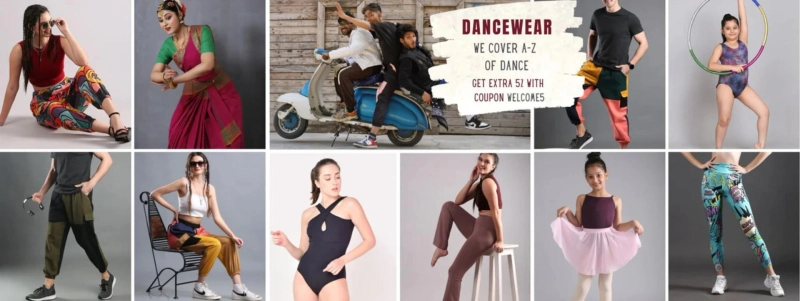India\'s cultural diversity is richly reflected in its traditional dance forms, each with its own unique attire that adds to the beauty and charm of the performance. At TheDanceBible, we celebrate these vibrant traditions by exploring the iconic costumes that define dances like Ghoomar, Dandiya, Garba, and other Rajasthani folk dances. Let\'s delve into the details of these mesmerizing ensembles.
Ghoomar Dance Costume: A Royal Affair
The Ghoomar dance, originating from Rajasthan, is known for its graceful twirls and elegant moves. This traditional dance is performed by women who wear the Ghoomar dance costume, which is a visual delight. The costume typically includes a ghagra, choli, and odhani.
- Ghagra: The long, flared skirt often made of vibrant colors like red, green, or blue, adorned with intricate mirror work, embroidery, and traditional motifs. The ghagra’s extensive flare allows for the signature twirls that Ghoomar is famous for.
- Choli: The blouse worn with the ghagra is usually heavily embellished and fitted, complementing the skirt. It can be sleeveless or have sleeves, based on regional variations.
- Odhani: The dupatta or scarf draped over the head and shoulders adds grace and modesty. It is typically decorated with mirror work, gota patti, or zari.
These elements combined create a regal and majestic look, embodying the heritage of Rajasthan’s royal past.
Dandiya Traditional Dress: The Spirit of Navratri
Dandiya, a lively and energetic dance from Gujarat, is performed during the Navratri festival. The Dandiya traditional dress is designed to be both eye-catching and functional for the energetic dance steps.
- Chaniya Choli: Women wear a chaniya choli, which includes a brightly colored and embellished ghagra (skirt), a choli (blouse), and a dupatta. The skirts are often made of cotton or silk and are adorned with mirror work, embroidery, and sequins.
- Kediyu and Kafni: Men wear a kediyu (a short, flared kurta) and kafni (dhoti-like trousers), often in vibrant colors and decorated with embroidery and mirror work.
The costumes are not only vibrant and beautiful but also designed to allow ease of movement for the energetic Dandiya Raas dance steps.
Garba Fancy Dress: Celebrating Culture with Color
Garba, another popular dance from Gujarat, often overlaps with Dandiya during Navratri. However, Garba is typically performed before Dandiya, and its costumes are equally striking.
- Traditional Garba Dress for Women: Women usually wear chaniya choli, similar to the Dandiya outfit but often with more flow and length in the skirts. The choli is often backless or tied with strings, adding to the festive and vibrant look.
- Men\'s Garba Attire: Men wear kafni pyjamas with a kediyu or a simple kurta. The kediyu is often intricately designed and is paired with a turban (pagdi) to complete the look.
The intricate designs and bright colors of Garba fancy dresses make the dancers stand out as they move in circular formations, celebrating the cultural essence of Gujarat.
Rajasthani Folk Dance Dress: An Ode to Tradition
Rajasthan is a treasure trove of folk dances, each with its distinctive costume. Besides Ghoomar, dances like Kalbeliya, Chari, and Bhavai are celebrated for their unique attire.
- Kalbeliya Dance Costume: The Kalbeliya dance, performed by the nomadic Kalbeliya tribe, features a costume that is as captivating as the dance itself. Women wear a long, black skirt decorated with silver thread and mirror work, paired with a similarly adorned choli and odhani. The black color represents the snake, which is central to the Kalbeliya culture.
- Chari Dance Costume: For the Chari dance, performed with a pot on the head, women wear brightly colored lehengas with extensive mirror work and embroidery, complemented by traditional jewelry.
- Bhavai Dance Costume: The Bhavai dance, known for its balancing acts, features a more conservative costume with a long, multi-layered skirt, a fitted blouse, and a dupatta, often heavily embellished.
These costumes are crafted to enhance the storytelling aspect of each dance, reflecting the vibrant culture and traditions of Rajasthan.
Embracing Tradition with TheDanceBible
At TheDanceBible, we cherish the beauty and heritage of traditional Indian dance costumes. These ensembles are more than just attire; they are a celebration of India\'s rich cultural tapestry. Whether it\'s the swirling skirts of Ghoomar, the vibrant chaniya cholis of Dandiya and Garba, or the ornate dresses of Rajasthani folk dances, each costume tells a story of tradition, artistry, and heritage.
By understanding and appreciating these traditional costumes, we honor the legacy of Indian dance and ensure that these cultural treasures continue to enchant audiences for generations to come.


